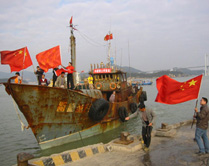
Chinese activists aboard two fishing boats returned to Xiamen port Saturday morning from Diaoyu Islands after breaking through encirclements by Japanese warships and planes and ensuing attacks 9 nautical miles off the islands.
It was the first such voyage jointly carried by Chinese companies and a non-governmental group to inspect tourism resources in the sea areas off the islands that belong to China, according to Li Yiqiang, one of 20 activists aboard the vessels.
Li is also a member of the federation of Chinese non-governmental organizations for defending sovereignty over the Diaoyu Islands.
The Diaoyu islands, in the East China Sea between China and Japan, have
belonged to China since ancient times. The islands are120 nautical miles northeast of Taiwan, 200 nautical miles west of the Chinese mainland and 200 nautical miles east of Japan's southernmost island Okinawa.
The activists from two Chinese companies and the federation began to return late Thursday after casting a monument inscribed with the words "Chinese territory Diaoyu Islands" into the sea.
The two boats were compelled to return after the activists were attacked by high-pressure water cannons from Japanese warships about 10 nautical miles off the islands at about 7:00 pm Thursday (Beijing Time), said Li Nan, who is in charge of logistics and coordination for the inspection tour of the islands.
The activists were greeted at the port with 30 people holding a banner that read "Welcome Diaoyu Islands defenders for a triumphant return." The activists were all exhausted after the 82-hour voyage on the sea which covered 400 nautical miles, Li Yiqiang said.
According to Li, the fishing boats encountered strong gales Wednesday which sickened the crew to varying extent. The wheelman of one fishing boat and Zhai Dongqing, one of the activists, both hurt in the attack, have received treatment on their return, and other crew members were generally well.
Li Yiqiang said they met Taiwanese coastal patrol vessels when they passed the sea area off Taipei on northern Taiwan Island Thursday morning. The Taiwanese vessels followed the fishing boats for a while and they later greeted each other. The activists were addressed by the Taiwanese as "dear mainland compatriots," and some Taiwanese officers thumbed up the activists.
Tong Zeng, federation director and chairman of Zhongxiang Investment Co. Ltd., said it was a legal inspection tour and the activists gained a lot of first-hand information on situations all the way to the islands. Tong said a report will be released soon as a preparatory work for opening the tour route from Xiamen to the islands.
Li Nan earlier told Xinhua that four Japanese warships and a plane appeared at about 3:00 pm Thursday when they were about 31nautical miles off the islands.
Two hours later, when the boats were about 20 nautical miles from the islands, the number of Japanese warships approaching the boats rose to 10, including five in front of the Chinese boats and another five behind and three planes above, said Li.
They followed the boats and did not attempt to intercept until 7:00 pm when the Chinese boats were about 10 nautical miles from the island. Japanese vessels sprayed the cabin of one Chinese boat, ruining its windshield and shattering glass, which injured the wheelman's face and arms.
Chinese activists threw eggs back at the warships. During the conflict, Zhai Dongqing strained his back.
Knowing that a landing on the islands was impossible, the Chinese activists released the stone monument inscribed "Chinese territory Diaoyu islands" into the sea near the archipelago.
The two boats left from Xiamen in east China's Fujian province on Tuesday night to inspect tourism resources in the sea areas off the islands.
The Diaoyu Islands first appeared on China's map during the Ming Dynasty (1368-1644). There are records about the islands in a book published during the rule of Emperor Yong Le (1403-1424) in the Ming Dynasty, more than 400 years before Japan claimed discovery of them in 1884. On a map published by Japan from 1783 to 1785, marking the boundary of the Ryukyu Kingdom, the Diaoyu islands were shown as belonging to China.
In April 1895, the government of the Qing Dynasty (1644-1911) was forced to sign the Treaty of Shimonoseki, under which China ceded the whole island of Taiwan and its surrounding islands including the Penghu Islands to Japan. Only since then has Japan had its own name for the area where the Diaoyu islands are located.
Japan was occupied by the United States after it was defeated in the Second World War. In 1951, Japan and the U.S. signed a treaty in San Francisco without the presence of China, one of the victor countries in the Second World War. Although article two of the treaty said Japan surrendered its claim over Taiwan and the Penghu islands, article three wrongly assigned the Diaoyu islands and other islands to the Ryukyu zone which was under US control.
The then Chinese Premier Zhou Enlai lodged a strong protest and said the Chinese government would never recognize the San Francisco Treaty.
(Xinhua News Agency January 17, 2004)
|

